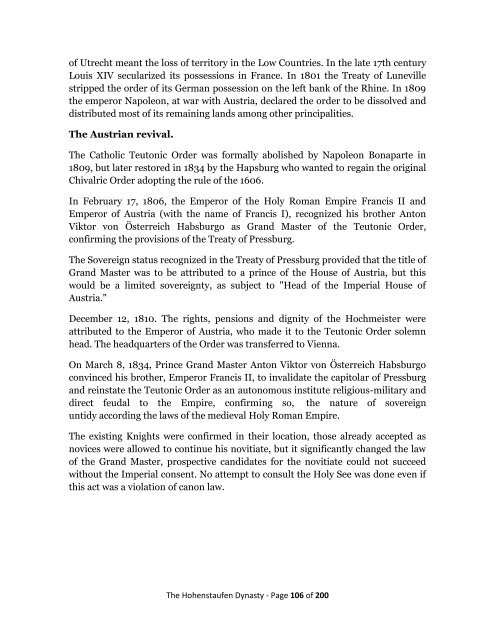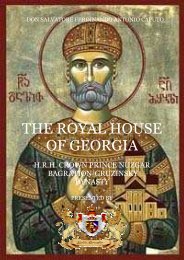here - Nobility Associations
here - Nobility Associations
here - Nobility Associations
Create successful ePaper yourself
Turn your PDF publications into a flip-book with our unique Google optimized e-Paper software.
of Utrecht meant the loss of territory in the Low Countries. In the late 17th century<br />
Louis XIV secularized its possessions in France. In 1801 the Treaty of Luneville<br />
stripped the order of its German possession on the left bank of the Rhine. In 1809<br />
the emperor Napoleon, at war with Austria, declared the order to be dissolved and<br />
distributed most of its remaining lands among other principalities.<br />
The Austrian revival.<br />
The Catholic Teutonic Order was formally abolished by Napoleon Bonaparte in<br />
1809, but later restored in 1834 by the Hapsburg who wanted to regain the original<br />
Chivalric Order adopting the rule of the 1606.<br />
In February 17, 1806, the Emperor of the Holy Roman Empire Francis II and<br />
Emperor of Austria (with the name of Francis I), recognized his brother Anton<br />
Viktor von Österreich Habsburgo as Grand Master of the Teutonic Order,<br />
confirming the provisions of the Treaty of Pressburg.<br />
The Sovereign status recognized in the Treaty of Pressburg provided that the title of<br />
Grand Master was to be attributed to a prince of the House of Austria, but this<br />
would be a limited sovereignty, as subject to "Head of the Imperial House of<br />
Austria."<br />
December 12, 1810. The rights, pensions and dignity of the Hochmeister were<br />
attributed to the Emperor of Austria, who made it to the Teutonic Order solemn<br />
head. The headquarters of the Order was transferred to Vienna.<br />
On March 8, 1834, Prince Grand Master Anton Viktor von Österreich Habsburgo<br />
convinced his brother, Emperor Francis II, to invalidate the capitolar of Pressburg<br />
and reinstate the Teutonic Order as an autonomous institute religious-military and<br />
direct feudal to the Empire, confirming so, the nature of sovereign<br />
untidy according the laws of the medieval Holy Roman Empire.<br />
The existing Knights were confirmed in their location, those already accepted as<br />
novices were allowed to continue his novitiate, but it significantly changed the law<br />
of the Grand Master, prospective candidates for the novitiate could not succeed<br />
without the Imperial consent. No attempt to consult the Holy See was done even if<br />
this act was a violation of canon law.<br />
The Hohenstaufen Dynasty - Page 106 of 200



